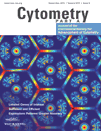
Experiment Overview
| Repository ID: | FR-FCM-ZZ69 | Experiment name: | HIV-envelope mediated cell-cell fusion: cell cycle analysis of fused and unfused cells | MIFlowCyt score: | 25.50% |
| Primary researcher: | Leonor Huerta | PI/manager: | Leonor Huerta | Uploaded by: | Leonor Huerta |
| Experiment dates: | 2011-12-12 - | Dataset uploaded: | Feb 2013 | Last updated: | Mar 2014 |
| Keywords: | [HIV] [flow cytometry] [cell cycle] [Cell-cell fusion] [syncytia] [absolute cell counting] | Manuscripts: | [11813199] [15958674] [16934339] [17014923] [19705036] [20508956] [21110955] [24442370] |
|
|
| Organizations: | None | ||||
| Purpose: | To allow the analysis of the cell cycle of fused and unfused cells in long-term HIV-envelope dependent syncytia formation experiments | ||||
| Conclusion: | This four-color flow cytometry method allows the analysis of the cell cycle status of cell population in cell-cell experiments. . Unfused CD4+ cells showed a cell cycle status typical of a proliferating cell line, whereas Env+ cells showed an arrest at the G1 phase. DNA synthesis activity was detected in 68% of the syncytia formed in the first 6 hours of co-culture, indicating an efficient recruitment of CD4+ proliferating cells. | ||||
| Comments: | We have previously shown that the labeling of fusion partners with fluorescent lipophilic probes (DiI and DiO) and analysis by flow cytometry, allow the quantification of cell fusion during HIV-envelope dependent syncytia formation (Huerta L. 2002. Cytometry 2002, 1; 47(2): 100-106; Huerta L. et al. J Virol Methods. 2006, 138(1-2): 17-23). Here, the cell cycle status of fused and unfused cells were determined in co-cultures of Jurkat HIV-1 envelope-expressing cells (Env+ cells) with CD4+ cells, using the labeling with lipophilic probes and a modification to the BrdU Flow Kit protocol (BD Biosciences) to preserve the fluorescence of the DiI and DiO probes trough the fixation and permeabilization procedures. For determination of the cell cycle status of cells during syncytium formation, the following gating was applied: 1) Viable cells were selected using a forward scatter (FSC-H) versus side scatter (SSC-H) dot plot, where a region was delineated excluding cell debris and dead cells. 2) Then, a FL1-H versus FL2-H dot plot was constructed for cells in R1. 3) By applying compensation as described in section 4.2, the DiI and DiO fluorescence allowed the discrimination of syncytia and unfused cells as double and single fluorescent particles, respectively. 4) The DNA content and anti-BrdU Ab fluorescence were detected in FL3-H vs. FL4-H, respectively (Fig.4). Fluorescence signal from 7-AAD was acquired in the linear amplification mode, whereas fluorescence signals generated by the other fluorochromes were acquired in the logarithmic mode. Regions were constructed for G1, S and G2 stages as shown in Figure 4, and composites gates were defined (e.g. R1+R2+R6) to obtain the percentages of cells at the different phases of the cell cycle. | ||||
| Funding: | Not disclosed | ||||
| Quality control: | To standardize voltage settings and compensation conditions, as well for definition of regions corresponding to fused and unfused cell populations, unlabeled and single-labeled cell suspensions were used as controls for each experiment and for each day in a given experiment. Minor adjustments of setting respective to those of the first day were needed for the analysis from the 3rd and 4th day samples, due to a slight but detectable loss of fluorescence intensity of the lipophilic probes. For cell cycle analysis of cells in cocultures, control non-cocultured CD4+ and Env+ cells were maintained in cultures wells in parallel with experimental wells. Cell cycle was assayed for all samples simultaneously. | ||||
